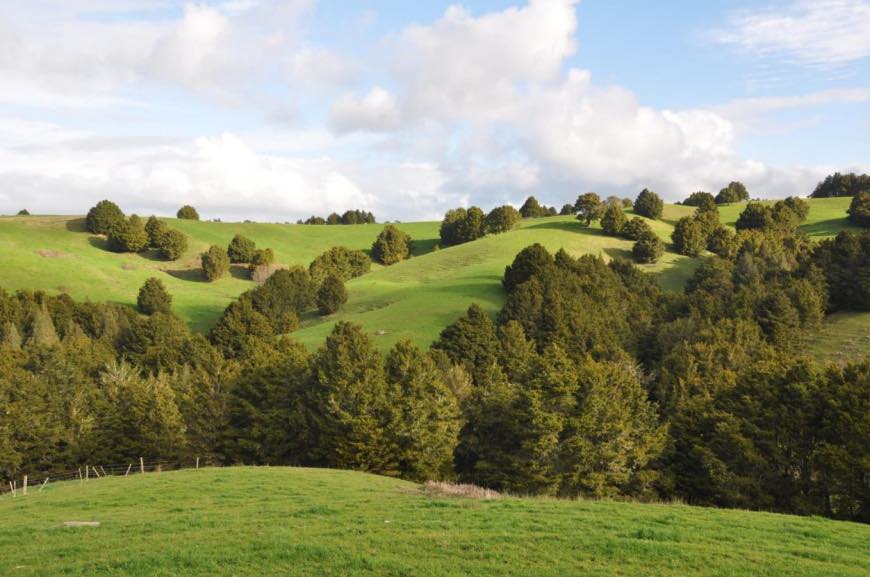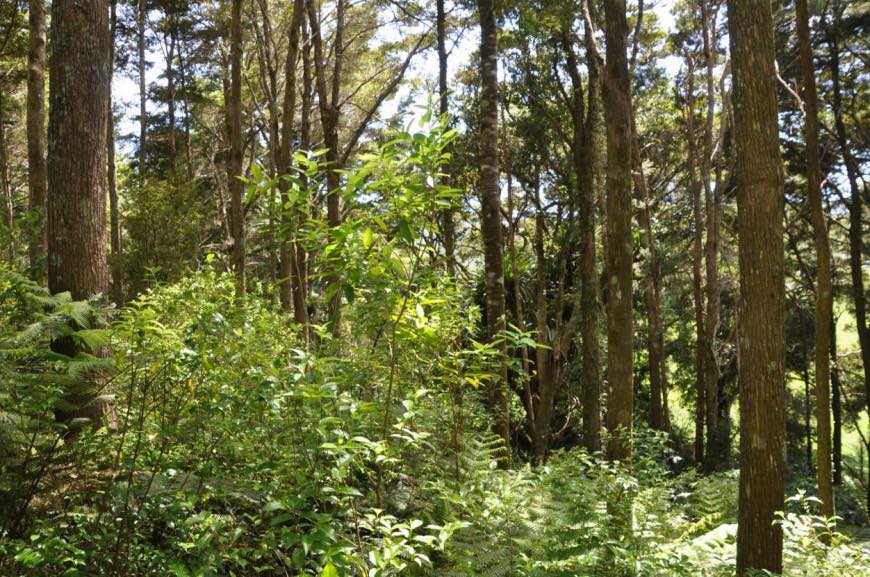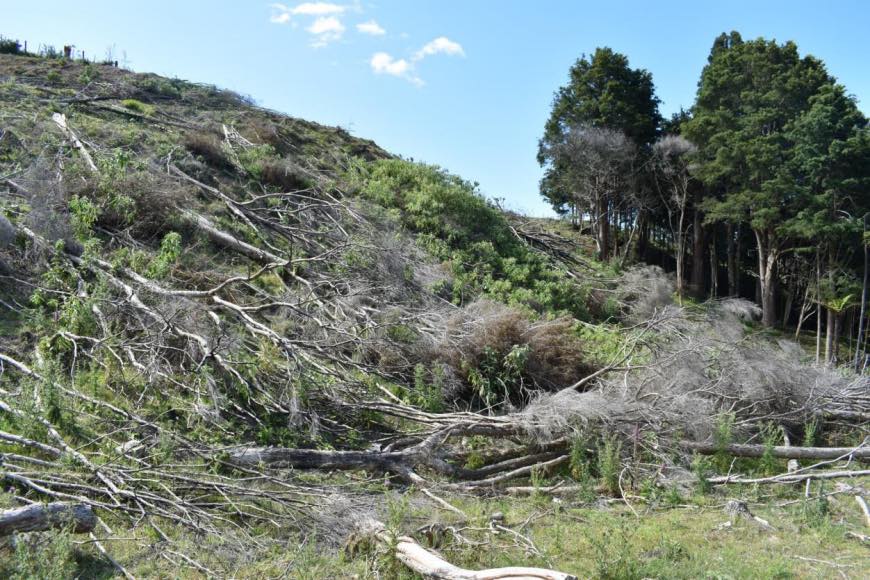Sustainable totara management and biodiversity conservation in Northland
Tuesday, March 21, 2017, School of Forestry blog
David Norton and Laura Young, School of Forestry, University of Canterbury, Christchurch. 9 December 2016
Public conservation (PCL) land makes up a relatively minor part of the Northland land area (12%), with beef and/or sheep farming and plantation forestry the predominant land uses (40% and 14% respectively). Perhaps not surprisingly, there is more native forest on private land than on public conservation land. Native woody vegetation (mature and regenerating native forest and manuka/kanuka) on protected land (PCL and QEII covenants) comprises 10% of Northland, while native woody vegetation on private land comprises another 18%. While some of the private native woody vegetation contains remnants of the original forest (although much of this has been cutover), substantial areas are secondary, having regenerated onto previously farmed land. Totara, kahikatea and kanuka are the most common tree species in these regenerating forests, with totara and kanuka more common on better drained sites and kahikatea on moister sites. Totara is particularly common on hill country and regeneration is actively occurring even in the presence of grazing (Bergin & Kimberley 2014).
Even though most forest on private land is not ‘old growth’, it still has important values for biodiversity conservation. Not only does it increase the total area of native forest in the Northland region (from 10% to 28%) it also substantially improves connectivity, which is important for native fauna, particularly birds. For example, in one Northland study the maximum distance brown kiwi travelled across pasture was 330 m but they were capable of walking between reserves up to 1.2 km apart if small forest remnants were present to act as stepping stones (Potter 1990). Our research on the spatial distribution of forest in Northland shows that when forest on public conservation land alone is considered, the average nearest neighbour distance between forest remnants is 1.2 km. However, when remnants (>10 ha) on private land are included, the average nearest neighbour distance decreases to 280 m and would be even less if smaller remnants (<10 ha) were also included (Young & Norton in prep). This result highlights the critical role that private native forest patches, even though they are small, can play in sustaining birds like kiwi as well as many other species.
While many of these secondary forests have relatively low species diversity compared to old growth forests (because they have relatively recently regenerated on grazed farmland), some harbour surprisingly rich native biodiversity. This will only increase with time, especially if grazing is excluded and pests are managed. Initial floristic surveys of three Northland predominantly cattle grazing properties with regenerating native woody vegetation found 100-110 native plant species associated with these patches, including 20-30 native woody species (Young & Norton unpubl. data). Even small regenerating totara stands can support a surprisingly high number of native woody species. For example, a 2.3 ha regenerating stand on one property had 25 native woody species (excluding vines and tree ferns) while a 0.3 ha stand had 11 native woody species, even though both were open to cattle grazing. Species richness is obviously higher the larger the stand, when grazing is excluded and when stands are more structurally complex.
The three Northland territorial authorities (Far North, Whangarei and Kaipara District Councils) have vegetation clearance rules within their District Plans to protect native forest on private land, but it is unclear how well these limit the clearing of regenerating forests. Young regenerating forest (<10 years old) is typically exempt from these rules and clearance
occurs reasonably widely, often through herbicide application. Anecdotal evidence suggests that clearance of older regenerating forest also occurs to some extent in order to win back pasture and perhaps closer to Whangarei, for firewood. There is little information, however, on the extent of this. When totara stands are cleared, steeper and rougher sites at least, rarely support good pasture and tend to regenerate back into kanuka or totara again, or into woody weeds such as woolly nightshade (tobacco plant), gorse and privot. Furthermore, even where regenerating native forest is protected under District Plan rules from clearance there is nothing to stop landowners from grazing these remnants which arrests the succession preventing development into a more diverse and structurally complex native forest.


One way to improve biodiversity conservation is to incentivise landowners to protect and manage native woody vegetation such as totara that has regenerated on previously farmed sites. This can be achieved through placing an economic value on woody vegetation. Totara has considerable potential for timber (Moodie et al. 2007), and because it is a naturally established forest (as opposed to a planted forest) it needs to be managed under the provisions of the Forests Act 1949. The Act defines sustainable forest management as “the management of an area of indigenous forest land in a way that maintains the ability of the forest growing on that land to continue to provide a full range of products and amenities in perpetuity while retaining the forest’s natural values.” The Act allows for sustainable timber harvesting under a sustainable forest management plan or permit and this is implemented through a requirement for continuous cover forestry involving removal of single trees or small groups (3-5 individuals) of trees only, and with only a proportion of the annual volume increment removed. A sustainable management plan developed under the Act is required to specify “(a) any necessary measures to be taken to protect the forest, and, in particular, to protect the regenerating forest from pest, stock, fire, and other threats; and (b) any necessary measures to retain and enhance flora and fauna and soil and water quality.” This sustainable management approach will encourage native biodiversity to develop and be sustained within a regenerating native forest stand and will result in the long-term improvement in biodiversity at both the farm and landscape scale. Additionally, the incentive to nurture, manage and protect current regenerating areas of seedling/sapling totara in paddocks as a potential economic resource will increase the total area in woody vegetation.

Both the Far North and Whangarei District Plans have provisions that allow sustainable forest management under a Ministry for Primary Industries (MPI) approved permit or plan as a permitted activity in these districts. This provision recognises the role that sustainable forest management can play in helping maintain native forest and its associated biodiversity on private land. We would argue that private native forest under a MPI sustainable management plan is likely to be better for native biodiversity than one that is just protected through vegetation clearance rules because of the requirement under the Forests Act to actively manage natural values including restricting or excluding grazing, particularly if some monitoring also takes place.
The development of a sustainable forestry programme focusing on regenerating totara forests on private land offers a real opportunity for enhanced biodiversity conservation in Northland. It provides a direct incentive for landowners to retain and better manage these regenerating forest patches which are otherwise of little or no economic value, while also providing other broader (community/public) benefits including creation of jobs, biodiversity conservation, aesthetics and enhanced water quality in stands associated with streams. Private native forests complement protected conservation land and contribute to the diversification of biodiversity conservation approaches in Northland (Blue & Blunden 2010). These benefits can be gained
at no cost to councils by allowing sustainable forest management of regenerating totara forest stands.
Acknowledgements
Our thanks to the Tindall Foundation for financial support and to David Bergin, Michael Bergin and Paul Quinlan for valuable discussion on sustainable totara management.
References
Bergin DO & Kimberley MO 2014. Factors influencing natural regeneration of totara (Podocarpus totara D.Don) on grazed hill country grassland in Northland, New Zealand. New Zealand Journal of Forestry Science 44:13 DOI: 10.1186/s40490-014-0013-8
Blue L & Blunden G 2010. (Re)making space for kiwi: beyond ‘fortress conservation’ in Northland. New Zealand Geographer 66, 105-123.
Moodie H, Quinlan P, Bergin D & Kennedy C. 2007. Totara – Northland’s farm forests of the future. New Zealand Tree Grower 2007.
Potter MA 1990. Movement of North Island brown kiwi (Apteryx australis mantelli) between forest remnants. New Zealand Journal of Ecology 14, 17-24.
Young LM & Norton DA. How do native trees on farms contribute to biodiversity conservation at regional and farm scales? Manuscript in preparation.
Disclaimer: Personal views expressed in this blog are those of the writers and do not necessarily represent those of the NZ Farm Forestry Association.

 Farm Forestry New Zealand
Farm Forestry New Zealand
No posts yet
Add a post